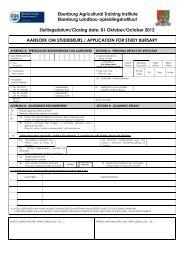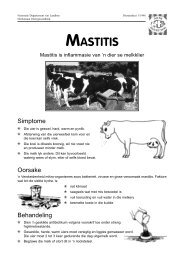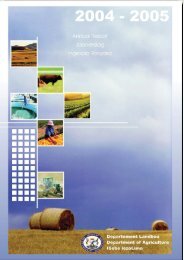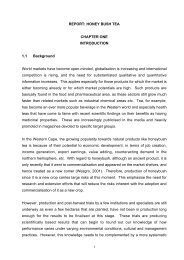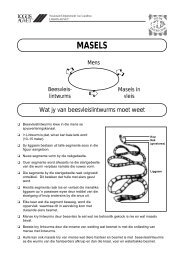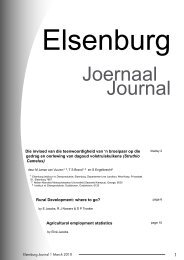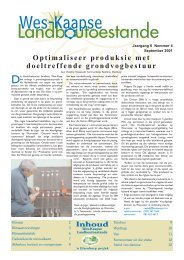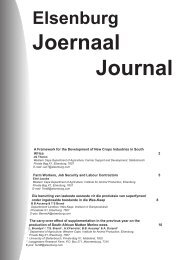The PROVIDE Project Standard Computable General Equilibrium ...
The PROVIDE Project Standard Computable General Equilibrium ...
The PROVIDE Project Standard Computable General Equilibrium ...
Create successful ePaper yourself
Turn your PDF publications into a flip-book with our unique Google optimized e-Paper software.
<strong>PROVIDE</strong> <strong>Project</strong> Technical Paper 2003: 3 October 2003<br />
<strong>The</strong> assumption of a two-stage production nest with Constant Elasticity of Substitution<br />
between aggregate intermediate input demand and aggregate value added and Leontief<br />
technology on intermediate inputs means that intermediate commodity demand (QINTD) is<br />
defined as the product of the fixed (Leontief) input coefficients of demand for commodity c<br />
by activity a (comactco), multiplied by the quantity of activity output (QX)<br />
QINTD = ∑ comactactco QINT . (X3)<br />
c c, a<br />
*<br />
a<br />
a<br />
Equation (X4) aggregates the commodity outputs by each activity (QXAC) to form the<br />
composite supplies of each commodity (QXC). It is assumed that the activity specific<br />
commodities are differentiated and therefore imperfect substitutes, hence the use of a CES<br />
xc<br />
xc<br />
aggregator function with adxc<br />
c<br />
as the shift parameter, δ<br />
ac ,<br />
as the share parameter and ρ<br />
c<br />
as<br />
the elasticity parameter.<br />
− 1<br />
xc<br />
ρc<br />
⎡<br />
xc<br />
xc<br />
−ρ<br />
⎤<br />
c<br />
QXCc = adxcc* ⎢∑ δac ,<br />
* QXACac<br />
, ⎥<br />
(X4)<br />
⎣ a<br />
⎦<br />
<strong>The</strong> matching first order condition for the optimal combination of commodity outputs is<br />
therefore given by<br />
⎛ xc<br />
1+<br />
ρ ⎞<br />
c −⎜ ⎟<br />
⎜ xc<br />
xc ρ ⎟<br />
xc<br />
⎡ xc<br />
− ρ ⎤ ⎝ c ⎠<br />
( c 1)<br />
c<br />
xc<br />
−ρ<br />
−<br />
PXACac ,<br />
= PXCc* adxcc* ⎢∑δac ,<br />
* QXACac , ⎥ * δac ,<br />
* QXACac<br />
,<br />
⎣ a<br />
⎦<br />
. (X5)<br />
⎛ xc<br />
1+<br />
ρ ⎞<br />
c −⎜ ⎟<br />
⎜ xc<br />
xc ρ ⎟<br />
xc<br />
⎡ xc<br />
− ρ ⎤ ⎝ c ⎠<br />
( c 1)<br />
c<br />
xc<br />
−ρ<br />
−<br />
= PXCc* QXCc* ⎢∑δac ,<br />
* QXACac , ⎥ * δac ,<br />
* QXACac<br />
,<br />
⎣ a<br />
⎦<br />
Finally the output to commodity supplies, where the ‘weights’ (actcomcomsh) identify the<br />
amount of each commodity produced per unit of output of each activity<br />
QXAC = actcomcomsh QX . (X6)<br />
ac , ac ,<br />
*<br />
a<br />
This equation not only captures the patterns of secondary production it also provides the<br />
market closure conditions for equality between the supply and demand of domestic output.<br />
3.3. Trade Block Equations<br />
Trade relationships are modeled using the Armington assumption of imperfect substitutability<br />
between domestic and foreign commodities. <strong>The</strong> set of nine equations provides a general<br />
structure that accommodates most eventualities found with single country CGE models. In<br />
particular these equations allow for traded and non-traded commodities while simultaneously<br />
accommodating commodities that are produced or not produced domestically and are<br />
consumed or not consumed domestically and allowing a relaxation of the small country<br />
assumption of price taking for exports.<br />
© S. McDonald<br />
21




